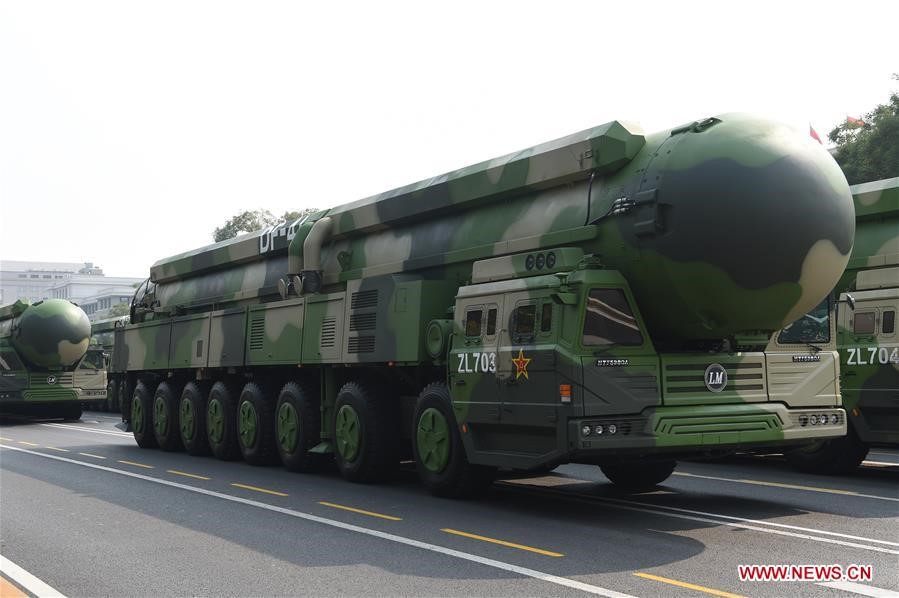Leaking information strategically is an area of expertise in which the Chinese regime excels. This week, while most military analysts were busy deciphering events in Russia’s war in Ukraine, Beijing cold-launched a new, anti-ship ballistic missile that appears to be a game-changer in the overall development of Chinese naval weapons systems and spread video images across the Internet. Unlike the country’s standard land-based, anti-ship ballistic missile capabilities, China’s advanced PLAN Type 055 destroyer appears capable of launching this new missile from the close confines of the ship’s Vertical Launch System (VLS) cells. According to the publication, The War Zone, “Layering in even short-range anti-ship ballistic missiles with air-breathing anti-ship cruise missiles would complicate even the most advanced naval adversary’s ability to defend itself.”
This launch occurred during the same week Washington announced a change in the US’ naval fleet architecture that will impact, according to the US Congressional Research Service, “the given level of overall fleet capability, so as to fit within expected future Navy budgets.” US navy force structure and shipbuilding plans remain vague after the 10-year mark and analysts say the budget plan is unlikely to fully meets US needs. To date, the Navy has not yet submitted an FY2023 30-year (FY2023-FY2052) shipbuilding plan despite statements from the Biden Administration that it will do so. In contrast, China’s President Xi Jinping labels his country’s defense spending a ”top priority” and releases information that point to advances in China’s force strength. The Chinese defense budget this year represents a 7.1% increase in real spending over last year.
“It is worth noting that a number of very-high-speed Chinese anti-ship cruise missile designs have emerged in recent years,” according to Tyler Rogoway of Defense One. In contrast, the US Navy is investigating whether it is possible to keep some Nimitz-class carrier operational longer to stretch the budget. DOD has yet to accurately define the specifics of its 30-year pipeline of new ships needed to maintain the fleet.
Earlier this week, another video began circulating on social media sites providing an unprecedented view of a Chinese Xian H-6N bomber carrying an air-launched anti-ship missile (ASBM). The large centerline missile it was carrying appears to be related to the YJ-21 (Eagle Strike 21) ballistic weapon. It is a good indication that Beijing is moving forward with advanced weapons capable of supporting its long-range strategic missions to expand China’s maritime domain while in Washington the US defense budget is seen lagging behind in new technologies and advances in ship-building. The ASBM is part of China’s anti-access/area-denial (A2/AD) strategy that can extend China air power approximately 900 miles off shore and provide its PLAAF pilots the option using a “carrier killer” hypersonic missile to attack moving warships at a steep angle of descent that it difficult to repel. Together, this week’s “leaks” by China strongly suggest that that US carrier groups will now need to remain farther from Chinese shores, making US fighter planes useless. What remains uncertain is the quality of China’s targeting capabilities, although US sources estimate that China has been working on the issue for more than a decade. “If China is… pursuing an air-launched hypersonic missile, such as a DF-17 mated to the H-6N, that would parallel similar developments in the United States,” according to Thomas Newdick, writing in “the War Zone.” China’s leadership appears ready to bring key enemy installations within its striking range and is confident enough to let the West know it. Xi Jinping is a strategic thinker and recognizes when and how to manipulate the news to magnify its impact. At a time when political elites and the general citizenry in the West are watching Russia’s “special military operation” in Ukraine with trepidation, Beijing exhibited technological advances that are likely intended to further challenge US military dominance and increase stress on Western military planners already concerned over Russian actions in Ukraine the speed of advanced military developments in China in recent years.
The Chinese Communist Party (CCP) party seeks to control information technology as a means to shape and censor the communications and opinions of its own people, as well as the communications of individuals beyond China’s borders.
Daria Novak served in the U.S. State Department. She currently teaches at a major university.
